Analysis of Negligence Claims in Business Law Context
VerifiedAdded on 2023/01/11
|7
|2191
|100
Homework Assignment
AI Summary
This assignment presents a detailed analysis of two negligence claims within a business law context. The first scenario involves a financial advisor, Slonia, whose negligent advice leads to a client's bankruptcy. The analysis focuses on establishing a duty of care, breach of that duty, and causation of financial damage, referencing key legal precedents like Donoghue v. Stevenson and Shaddock & Associates Pty Ltd v Parramatta City Council. The second scenario examines AK Manufacturing Ltd, a quadbike manufacturer, and a customer, Paul, who suffers physical injuries and financial loss due to a defective product. The analysis addresses the manufacturer's duty of care, potential breaches, and the establishment of causation, considering vicarious liability for employee actions and referencing cases like Paris v. Stepney Borough Council and Barnett v. Chelsea & Kensington Hospital. The assignment concludes that in both cases, negligence claims are likely to succeed based on the fulfillment of the necessary legal elements.
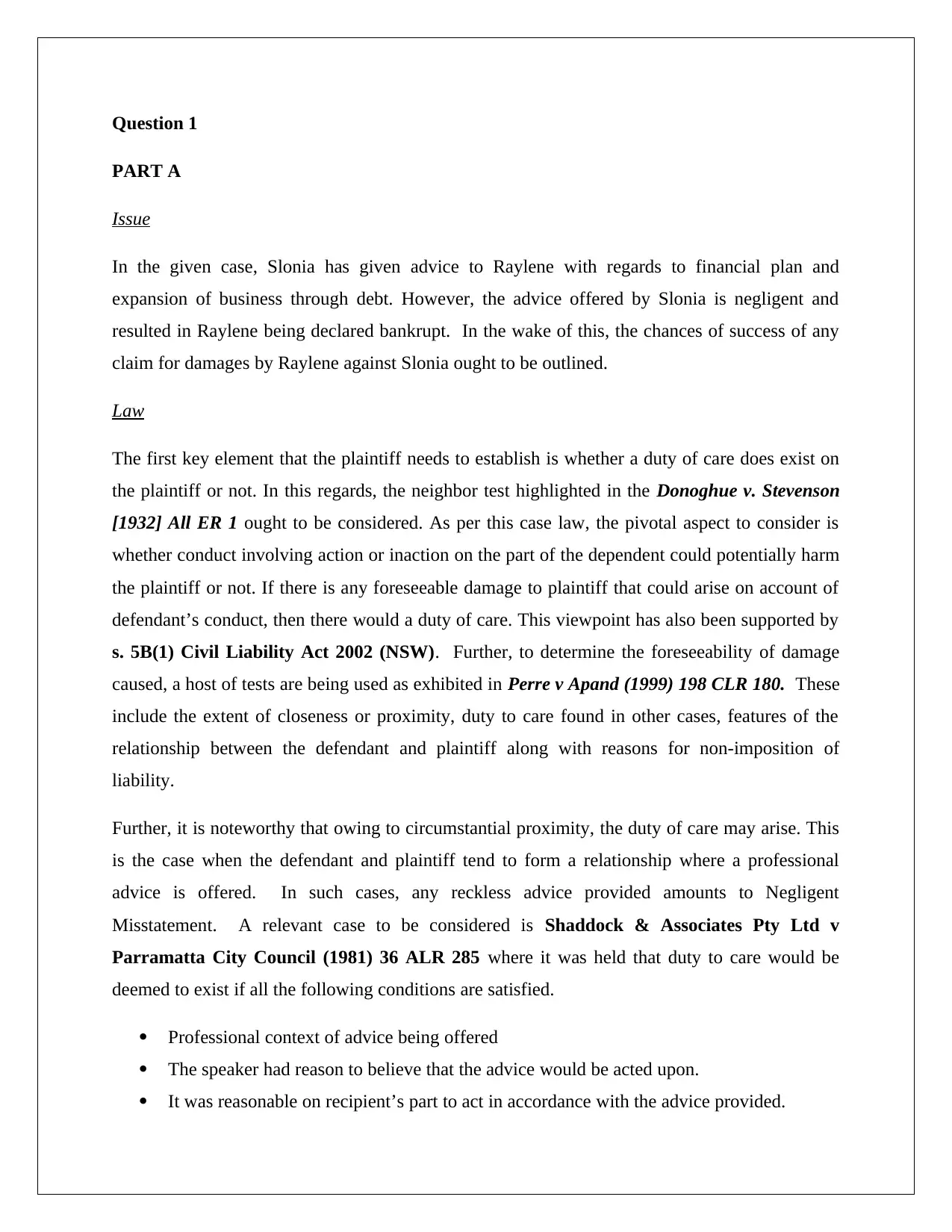
Question 1
PART A
Issue
In the given case, Slonia has given advice to Raylene with regards to financial plan and
expansion of business through debt. However, the advice offered by Slonia is negligent and
resulted in Raylene being declared bankrupt. In the wake of this, the chances of success of any
claim for damages by Raylene against Slonia ought to be outlined.
Law
The first key element that the plaintiff needs to establish is whether a duty of care does exist on
the plaintiff or not. In this regards, the neighbor test highlighted in the Donoghue v. Stevenson
[1932] All ER 1 ought to be considered. As per this case law, the pivotal aspect to consider is
whether conduct involving action or inaction on the part of the dependent could potentially harm
the plaintiff or not. If there is any foreseeable damage to plaintiff that could arise on account of
defendant’s conduct, then there would a duty of care. This viewpoint has also been supported by
s. 5B(1) Civil Liability Act 2002 (NSW). Further, to determine the foreseeability of damage
caused, a host of tests are being used as exhibited in Perre v Apand (1999) 198 CLR 180. These
include the extent of closeness or proximity, duty to care found in other cases, features of the
relationship between the defendant and plaintiff along with reasons for non-imposition of
liability.
Further, it is noteworthy that owing to circumstantial proximity, the duty of care may arise. This
is the case when the defendant and plaintiff tend to form a relationship where a professional
advice is offered. In such cases, any reckless advice provided amounts to Negligent
Misstatement. A relevant case to be considered is Shaddock & Associates Pty Ltd v
Parramatta City Council (1981) 36 ALR 285 where it was held that duty to care would be
deemed to exist if all the following conditions are satisfied.
Professional context of advice being offered
The speaker had reason to believe that the advice would be acted upon.
It was reasonable on recipient’s part to act in accordance with the advice provided.
PART A
Issue
In the given case, Slonia has given advice to Raylene with regards to financial plan and
expansion of business through debt. However, the advice offered by Slonia is negligent and
resulted in Raylene being declared bankrupt. In the wake of this, the chances of success of any
claim for damages by Raylene against Slonia ought to be outlined.
Law
The first key element that the plaintiff needs to establish is whether a duty of care does exist on
the plaintiff or not. In this regards, the neighbor test highlighted in the Donoghue v. Stevenson
[1932] All ER 1 ought to be considered. As per this case law, the pivotal aspect to consider is
whether conduct involving action or inaction on the part of the dependent could potentially harm
the plaintiff or not. If there is any foreseeable damage to plaintiff that could arise on account of
defendant’s conduct, then there would a duty of care. This viewpoint has also been supported by
s. 5B(1) Civil Liability Act 2002 (NSW). Further, to determine the foreseeability of damage
caused, a host of tests are being used as exhibited in Perre v Apand (1999) 198 CLR 180. These
include the extent of closeness or proximity, duty to care found in other cases, features of the
relationship between the defendant and plaintiff along with reasons for non-imposition of
liability.
Further, it is noteworthy that owing to circumstantial proximity, the duty of care may arise. This
is the case when the defendant and plaintiff tend to form a relationship where a professional
advice is offered. In such cases, any reckless advice provided amounts to Negligent
Misstatement. A relevant case to be considered is Shaddock & Associates Pty Ltd v
Parramatta City Council (1981) 36 ALR 285 where it was held that duty to care would be
deemed to exist if all the following conditions are satisfied.
Professional context of advice being offered
The speaker had reason to believe that the advice would be acted upon.
It was reasonable on recipient’s part to act in accordance with the advice provided.
Paraphrase This Document
Need a fresh take? Get an instant paraphrase of this document with our AI Paraphraser
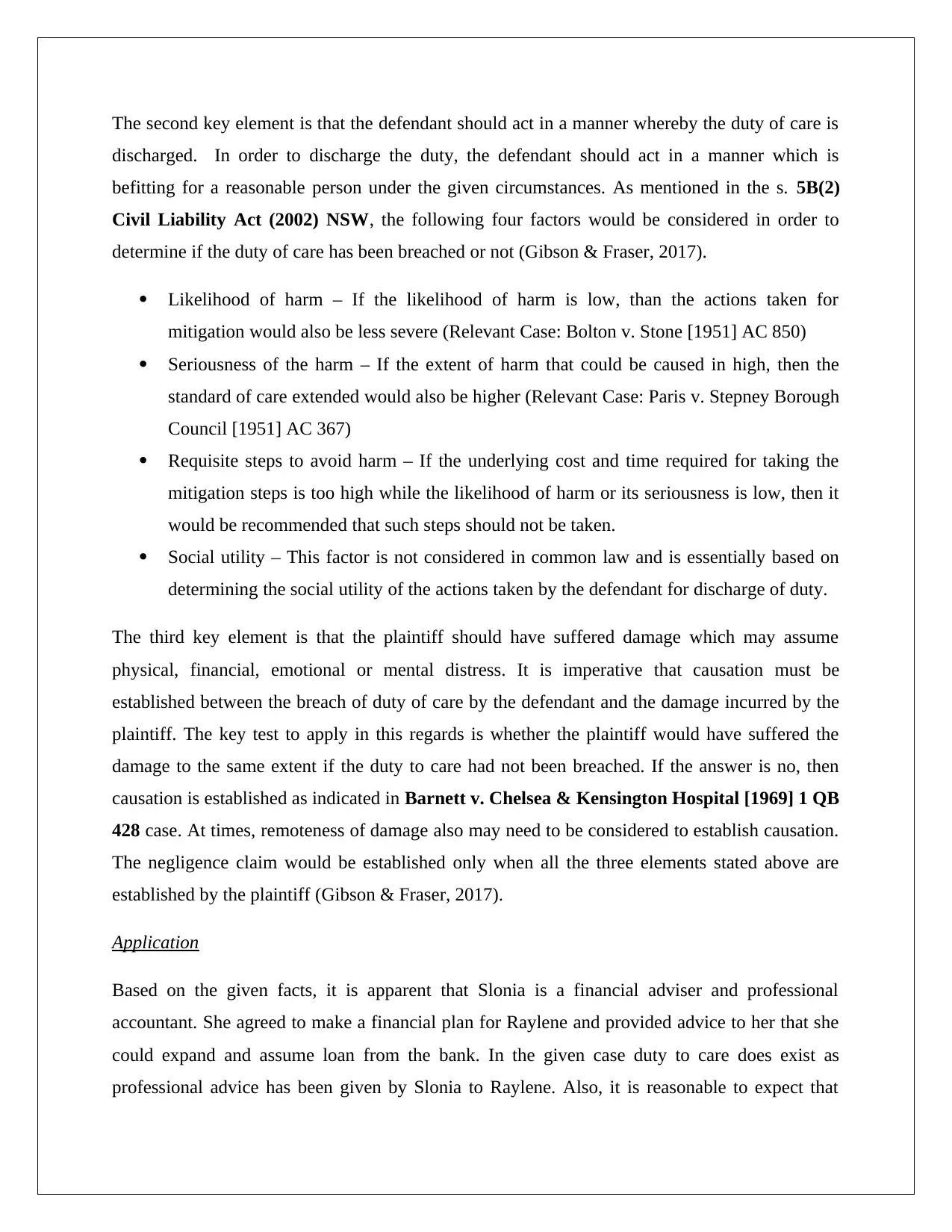
The second key element is that the defendant should act in a manner whereby the duty of care is
discharged. In order to discharge the duty, the defendant should act in a manner which is
befitting for a reasonable person under the given circumstances. As mentioned in the s. 5B(2)
Civil Liability Act (2002) NSW, the following four factors would be considered in order to
determine if the duty of care has been breached or not (Gibson & Fraser, 2017).
Likelihood of harm – If the likelihood of harm is low, than the actions taken for
mitigation would also be less severe (Relevant Case: Bolton v. Stone [1951] AC 850)
Seriousness of the harm – If the extent of harm that could be caused in high, then the
standard of care extended would also be higher (Relevant Case: Paris v. Stepney Borough
Council [1951] AC 367)
Requisite steps to avoid harm – If the underlying cost and time required for taking the
mitigation steps is too high while the likelihood of harm or its seriousness is low, then it
would be recommended that such steps should not be taken.
Social utility – This factor is not considered in common law and is essentially based on
determining the social utility of the actions taken by the defendant for discharge of duty.
The third key element is that the plaintiff should have suffered damage which may assume
physical, financial, emotional or mental distress. It is imperative that causation must be
established between the breach of duty of care by the defendant and the damage incurred by the
plaintiff. The key test to apply in this regards is whether the plaintiff would have suffered the
damage to the same extent if the duty to care had not been breached. If the answer is no, then
causation is established as indicated in Barnett v. Chelsea & Kensington Hospital [1969] 1 QB
428 case. At times, remoteness of damage also may need to be considered to establish causation.
The negligence claim would be established only when all the three elements stated above are
established by the plaintiff (Gibson & Fraser, 2017).
Application
Based on the given facts, it is apparent that Slonia is a financial adviser and professional
accountant. She agreed to make a financial plan for Raylene and provided advice to her that she
could expand and assume loan from the bank. In the given case duty to care does exist as
professional advice has been given by Slonia to Raylene. Also, it is reasonable to expect that
discharged. In order to discharge the duty, the defendant should act in a manner which is
befitting for a reasonable person under the given circumstances. As mentioned in the s. 5B(2)
Civil Liability Act (2002) NSW, the following four factors would be considered in order to
determine if the duty of care has been breached or not (Gibson & Fraser, 2017).
Likelihood of harm – If the likelihood of harm is low, than the actions taken for
mitigation would also be less severe (Relevant Case: Bolton v. Stone [1951] AC 850)
Seriousness of the harm – If the extent of harm that could be caused in high, then the
standard of care extended would also be higher (Relevant Case: Paris v. Stepney Borough
Council [1951] AC 367)
Requisite steps to avoid harm – If the underlying cost and time required for taking the
mitigation steps is too high while the likelihood of harm or its seriousness is low, then it
would be recommended that such steps should not be taken.
Social utility – This factor is not considered in common law and is essentially based on
determining the social utility of the actions taken by the defendant for discharge of duty.
The third key element is that the plaintiff should have suffered damage which may assume
physical, financial, emotional or mental distress. It is imperative that causation must be
established between the breach of duty of care by the defendant and the damage incurred by the
plaintiff. The key test to apply in this regards is whether the plaintiff would have suffered the
damage to the same extent if the duty to care had not been breached. If the answer is no, then
causation is established as indicated in Barnett v. Chelsea & Kensington Hospital [1969] 1 QB
428 case. At times, remoteness of damage also may need to be considered to establish causation.
The negligence claim would be established only when all the three elements stated above are
established by the plaintiff (Gibson & Fraser, 2017).
Application
Based on the given facts, it is apparent that Slonia is a financial adviser and professional
accountant. She agreed to make a financial plan for Raylene and provided advice to her that she
could expand and assume loan from the bank. In the given case duty to care does exist as
professional advice has been given by Slonia to Raylene. Also, it is reasonable to expect that
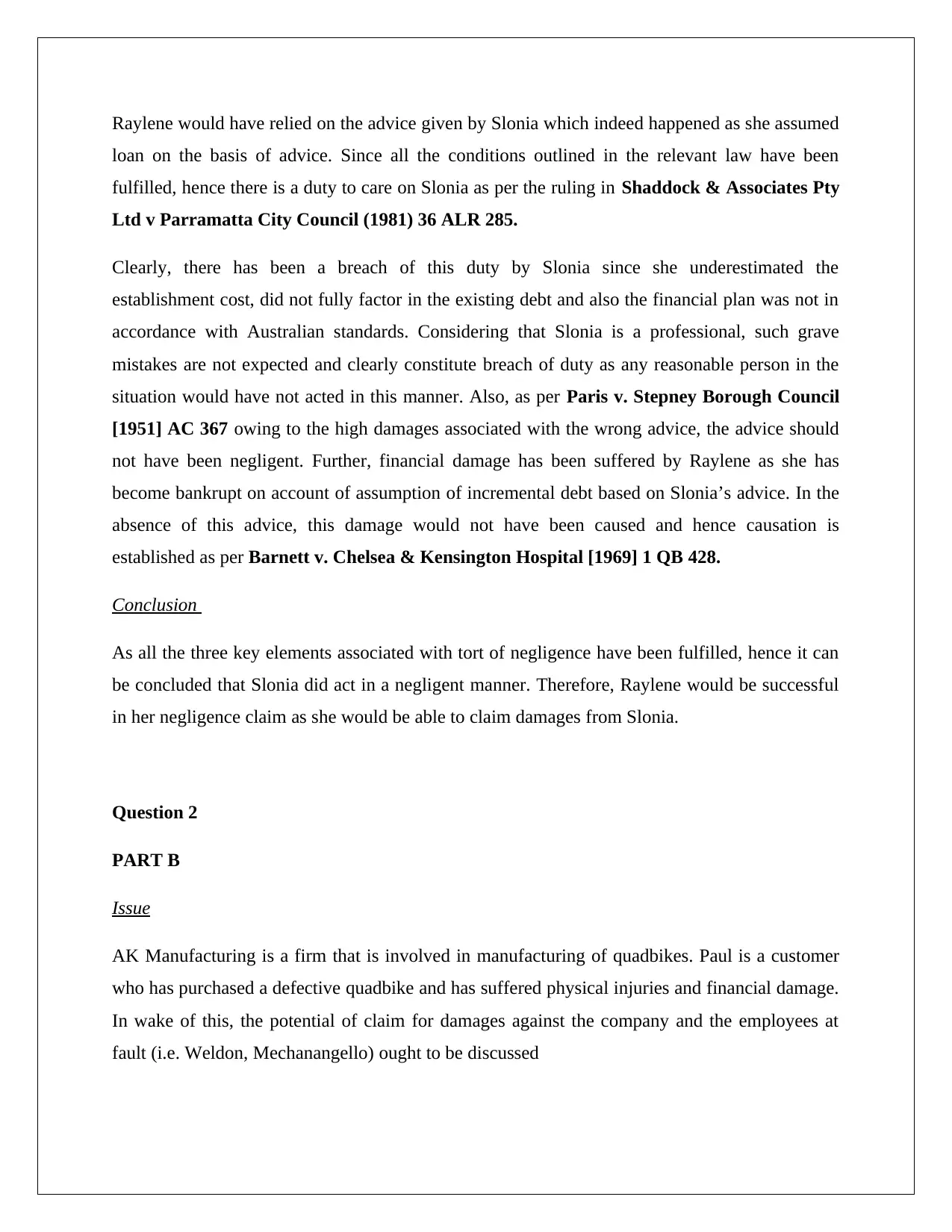
Raylene would have relied on the advice given by Slonia which indeed happened as she assumed
loan on the basis of advice. Since all the conditions outlined in the relevant law have been
fulfilled, hence there is a duty to care on Slonia as per the ruling in Shaddock & Associates Pty
Ltd v Parramatta City Council (1981) 36 ALR 285.
Clearly, there has been a breach of this duty by Slonia since she underestimated the
establishment cost, did not fully factor in the existing debt and also the financial plan was not in
accordance with Australian standards. Considering that Slonia is a professional, such grave
mistakes are not expected and clearly constitute breach of duty as any reasonable person in the
situation would have not acted in this manner. Also, as per Paris v. Stepney Borough Council
[1951] AC 367 owing to the high damages associated with the wrong advice, the advice should
not have been negligent. Further, financial damage has been suffered by Raylene as she has
become bankrupt on account of assumption of incremental debt based on Slonia’s advice. In the
absence of this advice, this damage would not have been caused and hence causation is
established as per Barnett v. Chelsea & Kensington Hospital [1969] 1 QB 428.
Conclusion
As all the three key elements associated with tort of negligence have been fulfilled, hence it can
be concluded that Slonia did act in a negligent manner. Therefore, Raylene would be successful
in her negligence claim as she would be able to claim damages from Slonia.
Question 2
PART B
Issue
AK Manufacturing is a firm that is involved in manufacturing of quadbikes. Paul is a customer
who has purchased a defective quadbike and has suffered physical injuries and financial damage.
In wake of this, the potential of claim for damages against the company and the employees at
fault (i.e. Weldon, Mechanangello) ought to be discussed
loan on the basis of advice. Since all the conditions outlined in the relevant law have been
fulfilled, hence there is a duty to care on Slonia as per the ruling in Shaddock & Associates Pty
Ltd v Parramatta City Council (1981) 36 ALR 285.
Clearly, there has been a breach of this duty by Slonia since she underestimated the
establishment cost, did not fully factor in the existing debt and also the financial plan was not in
accordance with Australian standards. Considering that Slonia is a professional, such grave
mistakes are not expected and clearly constitute breach of duty as any reasonable person in the
situation would have not acted in this manner. Also, as per Paris v. Stepney Borough Council
[1951] AC 367 owing to the high damages associated with the wrong advice, the advice should
not have been negligent. Further, financial damage has been suffered by Raylene as she has
become bankrupt on account of assumption of incremental debt based on Slonia’s advice. In the
absence of this advice, this damage would not have been caused and hence causation is
established as per Barnett v. Chelsea & Kensington Hospital [1969] 1 QB 428.
Conclusion
As all the three key elements associated with tort of negligence have been fulfilled, hence it can
be concluded that Slonia did act in a negligent manner. Therefore, Raylene would be successful
in her negligence claim as she would be able to claim damages from Slonia.
Question 2
PART B
Issue
AK Manufacturing is a firm that is involved in manufacturing of quadbikes. Paul is a customer
who has purchased a defective quadbike and has suffered physical injuries and financial damage.
In wake of this, the potential of claim for damages against the company and the employees at
fault (i.e. Weldon, Mechanangello) ought to be discussed
⊘ This is a preview!⊘
Do you want full access?
Subscribe today to unlock all pages.

Trusted by 1+ million students worldwide
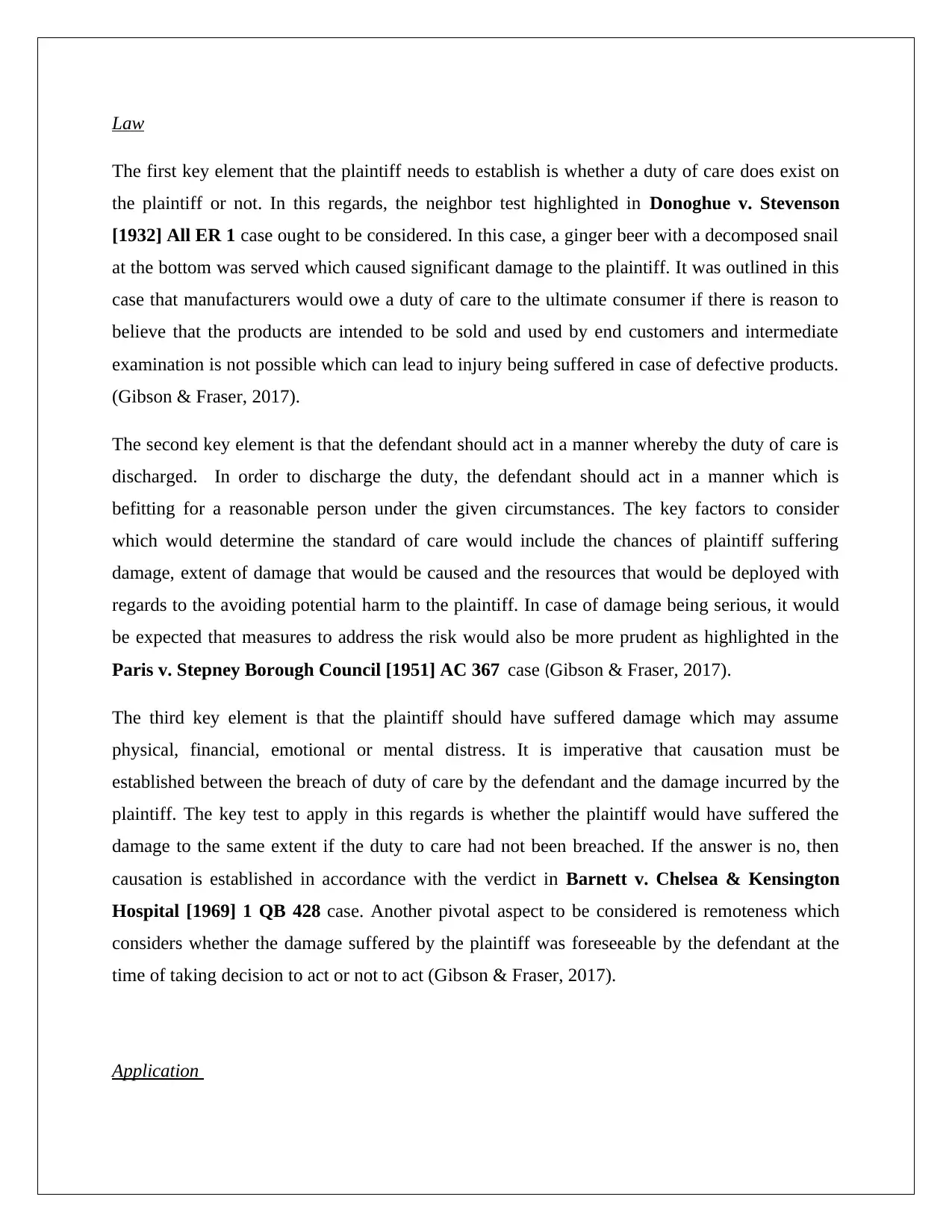
Law
The first key element that the plaintiff needs to establish is whether a duty of care does exist on
the plaintiff or not. In this regards, the neighbor test highlighted in Donoghue v. Stevenson
[1932] All ER 1 case ought to be considered. In this case, a ginger beer with a decomposed snail
at the bottom was served which caused significant damage to the plaintiff. It was outlined in this
case that manufacturers would owe a duty of care to the ultimate consumer if there is reason to
believe that the products are intended to be sold and used by end customers and intermediate
examination is not possible which can lead to injury being suffered in case of defective products.
(Gibson & Fraser, 2017).
The second key element is that the defendant should act in a manner whereby the duty of care is
discharged. In order to discharge the duty, the defendant should act in a manner which is
befitting for a reasonable person under the given circumstances. The key factors to consider
which would determine the standard of care would include the chances of plaintiff suffering
damage, extent of damage that would be caused and the resources that would be deployed with
regards to the avoiding potential harm to the plaintiff. In case of damage being serious, it would
be expected that measures to address the risk would also be more prudent as highlighted in the
Paris v. Stepney Borough Council [1951] AC 367 case (Gibson & Fraser, 2017).
The third key element is that the plaintiff should have suffered damage which may assume
physical, financial, emotional or mental distress. It is imperative that causation must be
established between the breach of duty of care by the defendant and the damage incurred by the
plaintiff. The key test to apply in this regards is whether the plaintiff would have suffered the
damage to the same extent if the duty to care had not been breached. If the answer is no, then
causation is established in accordance with the verdict in Barnett v. Chelsea & Kensington
Hospital [1969] 1 QB 428 case. Another pivotal aspect to be considered is remoteness which
considers whether the damage suffered by the plaintiff was foreseeable by the defendant at the
time of taking decision to act or not to act (Gibson & Fraser, 2017).
Application
The first key element that the plaintiff needs to establish is whether a duty of care does exist on
the plaintiff or not. In this regards, the neighbor test highlighted in Donoghue v. Stevenson
[1932] All ER 1 case ought to be considered. In this case, a ginger beer with a decomposed snail
at the bottom was served which caused significant damage to the plaintiff. It was outlined in this
case that manufacturers would owe a duty of care to the ultimate consumer if there is reason to
believe that the products are intended to be sold and used by end customers and intermediate
examination is not possible which can lead to injury being suffered in case of defective products.
(Gibson & Fraser, 2017).
The second key element is that the defendant should act in a manner whereby the duty of care is
discharged. In order to discharge the duty, the defendant should act in a manner which is
befitting for a reasonable person under the given circumstances. The key factors to consider
which would determine the standard of care would include the chances of plaintiff suffering
damage, extent of damage that would be caused and the resources that would be deployed with
regards to the avoiding potential harm to the plaintiff. In case of damage being serious, it would
be expected that measures to address the risk would also be more prudent as highlighted in the
Paris v. Stepney Borough Council [1951] AC 367 case (Gibson & Fraser, 2017).
The third key element is that the plaintiff should have suffered damage which may assume
physical, financial, emotional or mental distress. It is imperative that causation must be
established between the breach of duty of care by the defendant and the damage incurred by the
plaintiff. The key test to apply in this regards is whether the plaintiff would have suffered the
damage to the same extent if the duty to care had not been breached. If the answer is no, then
causation is established in accordance with the verdict in Barnett v. Chelsea & Kensington
Hospital [1969] 1 QB 428 case. Another pivotal aspect to be considered is remoteness which
considers whether the damage suffered by the plaintiff was foreseeable by the defendant at the
time of taking decision to act or not to act (Gibson & Fraser, 2017).
Application
Paraphrase This Document
Need a fresh take? Get an instant paraphrase of this document with our AI Paraphraser
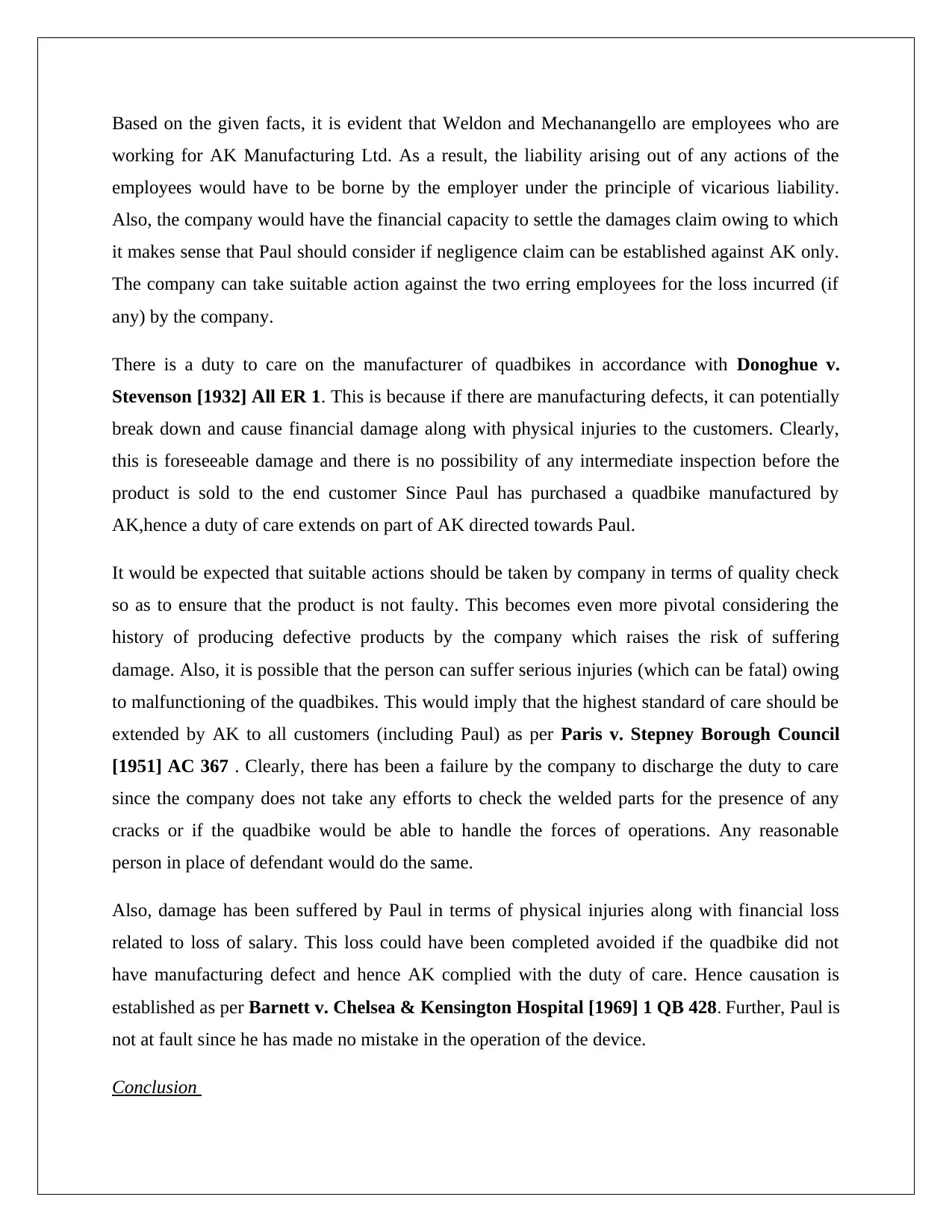
Based on the given facts, it is evident that Weldon and Mechanangello are employees who are
working for AK Manufacturing Ltd. As a result, the liability arising out of any actions of the
employees would have to be borne by the employer under the principle of vicarious liability.
Also, the company would have the financial capacity to settle the damages claim owing to which
it makes sense that Paul should consider if negligence claim can be established against AK only.
The company can take suitable action against the two erring employees for the loss incurred (if
any) by the company.
There is a duty to care on the manufacturer of quadbikes in accordance with Donoghue v.
Stevenson [1932] All ER 1. This is because if there are manufacturing defects, it can potentially
break down and cause financial damage along with physical injuries to the customers. Clearly,
this is foreseeable damage and there is no possibility of any intermediate inspection before the
product is sold to the end customer Since Paul has purchased a quadbike manufactured by
AK,hence a duty of care extends on part of AK directed towards Paul.
It would be expected that suitable actions should be taken by company in terms of quality check
so as to ensure that the product is not faulty. This becomes even more pivotal considering the
history of producing defective products by the company which raises the risk of suffering
damage. Also, it is possible that the person can suffer serious injuries (which can be fatal) owing
to malfunctioning of the quadbikes. This would imply that the highest standard of care should be
extended by AK to all customers (including Paul) as per Paris v. Stepney Borough Council
[1951] AC 367 . Clearly, there has been a failure by the company to discharge the duty to care
since the company does not take any efforts to check the welded parts for the presence of any
cracks or if the quadbike would be able to handle the forces of operations. Any reasonable
person in place of defendant would do the same.
Also, damage has been suffered by Paul in terms of physical injuries along with financial loss
related to loss of salary. This loss could have been completed avoided if the quadbike did not
have manufacturing defect and hence AK complied with the duty of care. Hence causation is
established as per Barnett v. Chelsea & Kensington Hospital [1969] 1 QB 428. Further, Paul is
not at fault since he has made no mistake in the operation of the device.
Conclusion
working for AK Manufacturing Ltd. As a result, the liability arising out of any actions of the
employees would have to be borne by the employer under the principle of vicarious liability.
Also, the company would have the financial capacity to settle the damages claim owing to which
it makes sense that Paul should consider if negligence claim can be established against AK only.
The company can take suitable action against the two erring employees for the loss incurred (if
any) by the company.
There is a duty to care on the manufacturer of quadbikes in accordance with Donoghue v.
Stevenson [1932] All ER 1. This is because if there are manufacturing defects, it can potentially
break down and cause financial damage along with physical injuries to the customers. Clearly,
this is foreseeable damage and there is no possibility of any intermediate inspection before the
product is sold to the end customer Since Paul has purchased a quadbike manufactured by
AK,hence a duty of care extends on part of AK directed towards Paul.
It would be expected that suitable actions should be taken by company in terms of quality check
so as to ensure that the product is not faulty. This becomes even more pivotal considering the
history of producing defective products by the company which raises the risk of suffering
damage. Also, it is possible that the person can suffer serious injuries (which can be fatal) owing
to malfunctioning of the quadbikes. This would imply that the highest standard of care should be
extended by AK to all customers (including Paul) as per Paris v. Stepney Borough Council
[1951] AC 367 . Clearly, there has been a failure by the company to discharge the duty to care
since the company does not take any efforts to check the welded parts for the presence of any
cracks or if the quadbike would be able to handle the forces of operations. Any reasonable
person in place of defendant would do the same.
Also, damage has been suffered by Paul in terms of physical injuries along with financial loss
related to loss of salary. This loss could have been completed avoided if the quadbike did not
have manufacturing defect and hence AK complied with the duty of care. Hence causation is
established as per Barnett v. Chelsea & Kensington Hospital [1969] 1 QB 428. Further, Paul is
not at fault since he has made no mistake in the operation of the device.
Conclusion
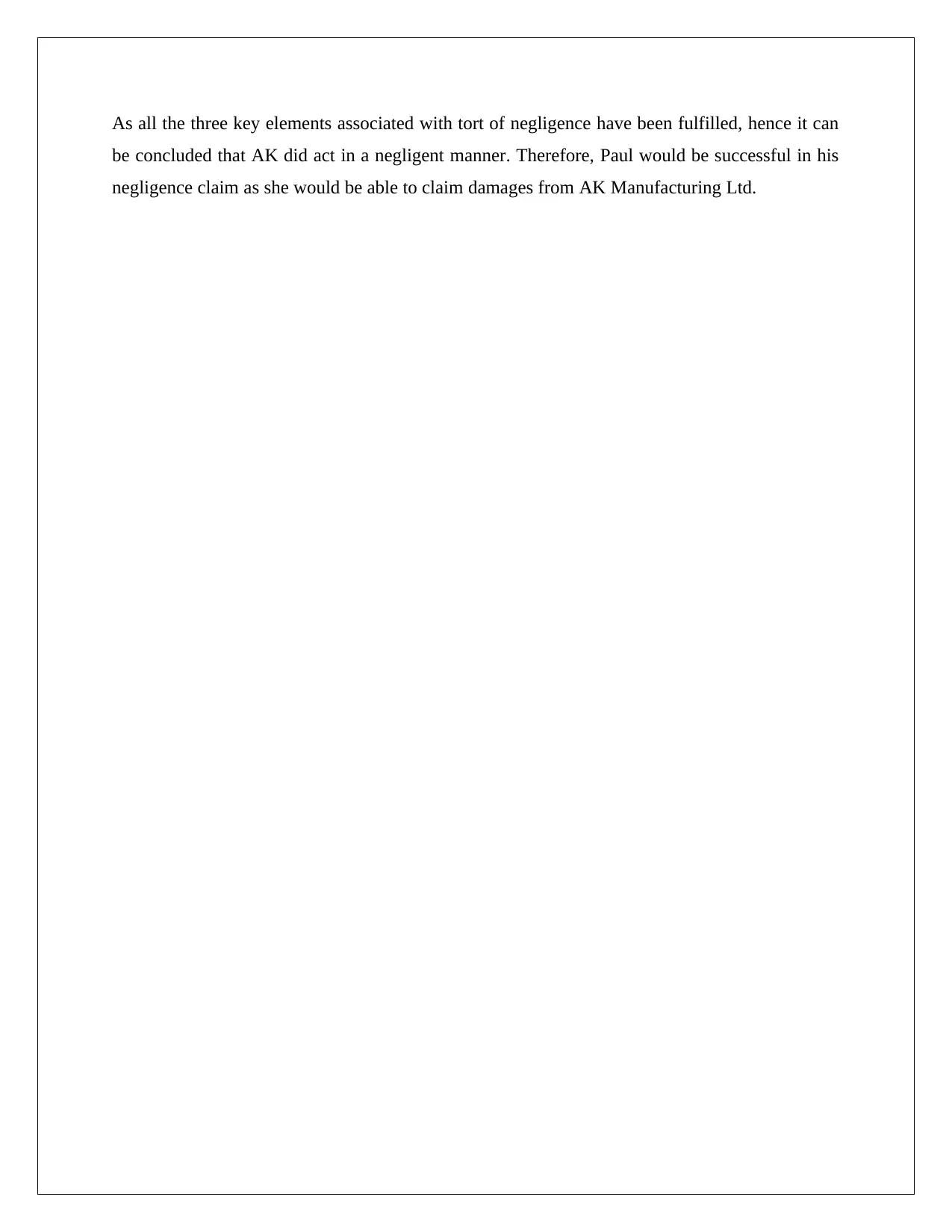
As all the three key elements associated with tort of negligence have been fulfilled, hence it can
be concluded that AK did act in a negligent manner. Therefore, Paul would be successful in his
negligence claim as she would be able to claim damages from AK Manufacturing Ltd.
be concluded that AK did act in a negligent manner. Therefore, Paul would be successful in his
negligence claim as she would be able to claim damages from AK Manufacturing Ltd.
⊘ This is a preview!⊘
Do you want full access?
Subscribe today to unlock all pages.

Trusted by 1+ million students worldwide
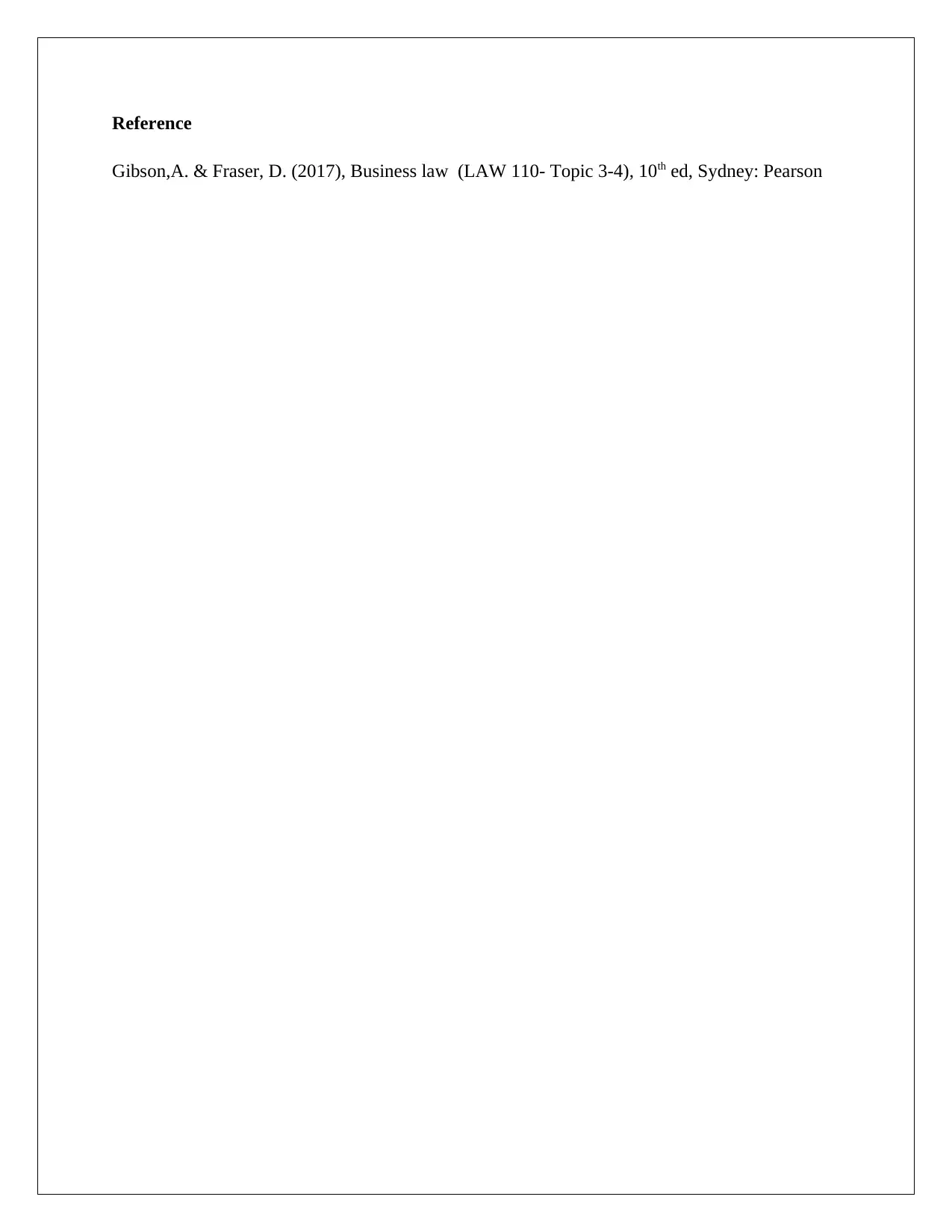
Reference
Gibson,A. & Fraser, D. (2017), Business law (LAW 110- Topic 3-4), 10th ed, Sydney: Pearson
Gibson,A. & Fraser, D. (2017), Business law (LAW 110- Topic 3-4), 10th ed, Sydney: Pearson
1 out of 7
Related Documents
Your All-in-One AI-Powered Toolkit for Academic Success.
+13062052269
info@desklib.com
Available 24*7 on WhatsApp / Email
![[object Object]](/_next/static/media/star-bottom.7253800d.svg)
Unlock your academic potential
Copyright © 2020–2025 A2Z Services. All Rights Reserved. Developed and managed by ZUCOL.





